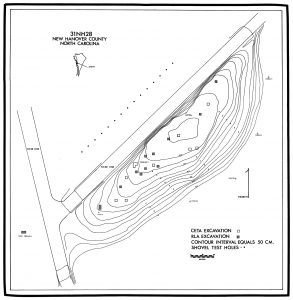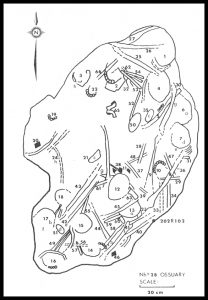Cold Morning (Woodland)
Cold Morning (31NH28) is a very unique ossuary excavated in New Hanover country. It is located just south of Wilmington on a relict sand dune near Barnard’s Creek, a few hundred feet north of where the creek empties into the Cape Fear. Cold Morning is an important site because there are very few early accounts of Native peoples in this area, so we don’t know much about the people who would have been living here.
History of Excavations

Initial excavations at Cold Morning took place in 1977 as part of a Comprehensive Employment Training Act (C.E.T.A.) sponsored project called the New Hanover County Archaeological Survey. At this time, 11 two meter square test pits were excavated, which exposed the ossuary in three connected units. The skeletal material was uncovered, a scale drawing was made, and photographs were taken. A wooden cover was then placed over the ossuary to protect it until it could be examined in place by a physical anthropologist. In June of 1978, the skeletal material was examined by Dr. David S. Weaver of Wake Forest University. At that point, the ossuary was then covered with a layer of clean white sand and the excavations were backfilled for protection until they could be removed by professional archaeologists.

From October 1 through October 19 in 1979, archaeologists from the Research Laboratories of Archaeology at UNC-Chapel Hill conducted salvage excavations at the site. These were done in advance of construction taking place for the Echo Farms subdivision that would have destroyed the ossuary. The RLA re-excavated and removed the skeletal material and conducted additional excavations to determine the size of the site. The archaeologists also wanted to find out if there were any stratified deposits that could help with cultural dating, particularly in terms of associating the ossuary with the various Woodland ceramics present. Ultimately, the RLA excavated 12 2-meter square pits, a 1 x 4 meter trench, and 35 shovel tests at the site.
Research Questions
The village associated with the Cold Morning ossuary would have been close by, but it was probably destroyed by road construction and a large borrow pit that was near the site.

As mentioned above, because we do not know much about the Native peoples in this area, the ossuary provided an important glimpse into the lives of the people who would have lived around Cold Morning. Most of the remains were randomly scattered throughout the ossuary, without any evidence of articulation. This does not mean that people were careless; instead, it indicates that the bones were defleshed at some point before they were reburied. Skeletal analysis indicated that there were at least 11 adults (six women, four men, and one person of indeterminate sex), four children aged 12 or younger (one child of 12-14, one 8 year old, a 5 year old, and a 3 year old), and one fetus contained within the ossuary. The number of people is a conservative estimate; given the acidity of the soil, it is certainly possible that there were originally more people buried here. At least six of the adults would have been middle-aged or older. The only skeletal remains found together were those of the baby that was 37 weeks or younger when it died. The only artifacts recovered from the ossuary were ceramics.

Dating indicates that this is a Late Woodland ossuary, which ties in well with the fact that we do not have similar mass burials from Early Woodland or Middle Woodland contexts. Some of the ceramics from the ossuary appear to have limestone added as part of the temper (material added to clay that helps strengthen it, particularly while it is being fired and used), a practice which archaeologists had thought was limited to Early and Middle Woodland contexts. However, based on the evidence from the Cold Morning ossuary and other decorations on the pottery, it now looks like the use of marl (unconsolidated sediment made up of clay or lime) or limestone for temper was continued into the Late Woodland in some areas.
In addition, the Cold Morning ossuary is somewhat unusual when it is compared to mass graves found more northward in Onslow County. Part of what stands out is the small size of the ossuary and the lack of bone bundles. However, the biggest difference is in the skeletal remains themselves. Cranial morphology indicates that there are strong similarities between the people who were interred at Cold Morning and Siouan groups from the Piedmont. When compared to geographically closer Alongkian groups in Onslow and Pender counties, there were marked differences. This tells us that at some level, the people living south of the Cape Fear River were quite different physically from the Algonkian coastal peoples to the north. Still, this doesn’t tell us how different both groups of people might have been culturally, outside of the fact that they had different ceramic traditions and practiced different forms of burial.
Sources
Coe, Joffre L., H. T. Ward, M. Graham, L. Navey, H. Hogue, and J. H. Wilson, Jr.
1982 • Archaeological and Paleo-osteological Investigations at the Cold Morning Site, New Hanover County, North Carolina. Report prepared for the Interagency Archeological Services (Atlanta) by the Research Laboratories of Anthropology, University of North Carolina, Chapel Hill.
Ward, Trawick H., and R. P. Stephen Davis, Jr.
1998 • Time Before History: The Archaeology of North Carolina. University of North Carolina Press, Chapel Hill.
